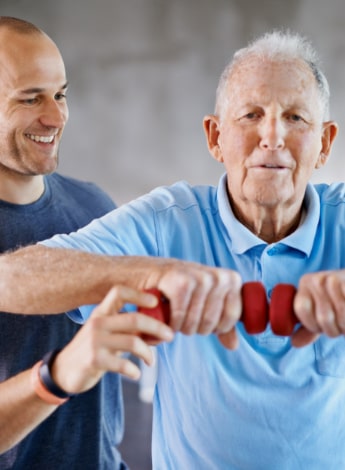
Five facts about … physiotherapy cancer care

Here are five discussion points about the role of physiotherapy across the cancer continuum of care.
1. Physical activity can reduce the risk of many cancers
There is strong evidence that shows leading an active lifestyle reduces the risk of breast, colon, kidney, endometrial, bladder, stomach and oesophageal cancer, by 10 to 24 per cent (Patel et al 2019).
Physiotherapists can promote the benefits of a physically active lifestyle to those who are otherwise healthy, whom we might engage with when screening for injury prevention at sports clubs, schools, or workplaces.
Many of the therapeutic modalities that physiotherapists employ to treat clients with chronic pain, musculoskeletal, neurological or cardiopulmonary conditions will facilitate those clients to be more physically active.
This can in turn lead to the use of physical activity in the self-management of these conditions, as well as the other health benefits of being more physically active, such as reduced cancer risk.
There are many other healthy lifestyle behaviours that physiotherapists can encourage in their clients.
As primary health practitioners, physiotherapists can discuss smoking cessation with clients.
Smoking cessation advice can be given over multiple treatment sessions employing education, follow-up and reassessment (Bodner et al 2020).
There is one cancer with an unfavourable link with physical activity— being more physically active is associated with an increased risk of melanoma, which means physiotherapy has a role in emphasising sun safe practices with our patients too (Patel et al 2019).
2. Prehabilitation can maximise adherence to cancer therapy and reduce complications
Cancer prehabilitation occurs between the time of diagnosis and the commencement of treatment.
It should underpin the whole cancer pathway and be part of the continuum of preventative, restorative, supportive and palliative interventions (Macmillan 2017).
Prehabilitation starts with a thorough assessment of baseline outcome measures, identification of risk factors and education about the oncology treatment (Macmillan 2017).
Physiotherapists and other health professionals deliver exercise, nutrition and psychological health interventions during prehabilitation.

This helps to improve resilience to the effects of cancer treatment, reduce length of stay in hospital, enhance recovery and reduce treatment complications, improve cardiorespiratory fitness and improve quality of life (QOL).
Exercise and physical activity is a fundamental component of prehabilitation (Macmillan 2017).
Exercise prescriptions should be personalised to the individual, taking into account their specific needs, oncology treatments and likely side- effects.
Both cardiovascular and resistance exercises should be prescribed and supervised by a physiotherapist.
The length of the prehabilitation program varies from one week to two months, with benefits being seen in as little as two weeks.
The timeframe is dependent upon the urgency of the oncology treatment required (Macmillan 2017).
Prehabilitation has been shown to empower people with cancer by fostering a sense of control and purpose in an otherwise uncertain time.
3. Exercise is safe and beneficial during and after cancer treatment
Exercise is an effective and safe way to reduce cancer-related fatigue and to improve QOL in patients.
Exercise during chemotherapy can minimise the burden of side-effects.
High symptom burden can lead to chemotherapy dose reduction or discontinued treatment, which in turn may influence prognosis (Mijwel et al 2018).
To accommodate fluctuating symptoms, adjustment of the intensity, type and frequency of exercise will need to occur, often daily.

Previously active people should be encouraged to stay active as much as possible, while previously sedentary people should be encouraged to commence slowly and progress steadily under the supervision of a physiotherapist.
Physiotherapists regularly adjust exercise prescriptions to accommodate treatment plans, side- effects and comorbidities such as arthritis or reduced balance.
It may be appropriate to seek medical clearance before exercise testing and prescription if the patient has significant cardiovascular health concerns or signs of immunocompromise (eg, during chemotherapy).
Provision of ongoing motivation and support are important for self-efficacy and adherence.
In order to address cancer-related side- effects, the evidence base states patients should be prescribed an 8–12 week exercise program including moderate-intensity aerobic exercise ≥3 times per week, ≥30 min per session; plus resistance training ≥2 times per week, ≥2 sets of 8 to 15 repetitions at ≥60% of one repetition maximum (Campbell et al 2019).
4. Early detection and management of treatment problems can improve outcomes
Treatment for cancer commonly cause impairments and functional limitations.
For example, breast cancer treatment may cause pain, muscle weakness, reduced range of motion, neuropathy and lymphoedema (Hayes et al 2012).
Cancer treatments are also associated with fatigue, deconditioning, changes in body composition and osteoporosis (Stout et al 2012).
Rather than waiting for a patient to present with a problem, the prospective surveillance model of care is proactive, with regular reviews before, during and after cancer treatment.
Physiotherapists are involved in prospective surveillance and management of impairments, to educate and promote healthy behaviours such as physical activity, and to refer to other members of the multidisciplinary team as required.
At the initial assessment, pre-morbid conditions can also be identified (Stout et al 2012), which may impact planned cancer treatment (eg, a shoulder injury may restrict the radiation therapy position).
Prospective surveillance using bioimpedance spectroscopy has been shown to detect subclinical lymphoedema in women with breast cancer (Shah et al 2016).
This enables early intervention and can reduce progression to clinical lymphoedema (Koelmeyer et al 2020).
While initially proposed for breast cancer rehabilitation, prospective surveillance is now more widely applied in oncology rehabilitation in general.
Physiotherapists have a key role to play in its implementation and evaluation to improve outcomes for people with cancer.
5. The role of physiotherapy in palliative care is diverse, and patient-specific
‘Palliative care is care that helps people live their life as fully and as comfortably as possible when living with a life-limiting or terminal illness’ (Palliative Care Australia).
The role of physiotherapy in palliative care is diverse and patient-specific.
Physiotherapists working in palliative care adapt and tailor a wide range of physiotherapy techniques.
Laakso and colleagues (2003) found physiotherapists working with palliative patients on an oncology ward delivered pain and symptom management, lymphoedema management, education to carers about safe transfer and handling techniques, and/or mobility and exercise programs.
Patients who received treatment from an experienced palliative care physiotherapist were more likely to be discharged and die at home, with no significant increase in length of stay compared to usual care.
There were also improvements in fatigue, pain and appetite and maintenance or improvement of functional aspects of QOL.
Physiotherapy interventions in the palliative care setting include:
- collaborative goal setting to maintain functional independence and QOL in the face of advancing disease
- personalised exercise prescription
- assessing potential for improvements in mobility and function, gait aid prescription
- easing of carer burden through carer education
- lymphoedema management
- respiratory care including non- pharmacological management of breathlessness
- non-pharmacological management of musculoskeletal pain
- fatigue management strategies
- fall minimisation strategies (Wittry 2018, Heywood 2018).
Click here for an infographic poster version.
Bios
APA Research Physiotherapist Dr Elise Gane is a Conjoint Research Fellow between The University of Queensland and Princess Alexandra Hospital. In this role, Elise is a mentor for physiotherapists conducting clinical research projects. She has research interests in cancer rehabilitation, lymphoedema, musculoskeletal injuries, and return-to-work after injury or illness.
Jayne Grubits-Kingand, APAM, works in private practice in Ulverstone, Tasmania, and sees a mixed caseload of clients, the majority being musculoskeleletal and neurological conditions. Jayne is a certified PINC cancer rehabilitation physiotherapist and is studying a Master of Exercise Medicine (oncology) through Edith Cowan University. She is the Tasmanian chair of the APA Cancer, Palliative Care and Lymphoedema group and a member of the APA Tasmanian state branch council.
Leah McIntyre, APAM, has been working in cancer services at the Mater Hospital Brisbane for12 years. As well as being a physiotherapist, Leah has completed lymphoedema training and is a PINC and Steel certified cancer rehab therapist. She works with cancer patients in inpatient and outpatient settings, and has a strong focus on QOL in survivorship.
Dr Sharon Czerniec, APAM, is a physiotherapist and lymphoedema therapist with a clinical and research focus on lymphoedema and post-cancer rehabilitation. Sharon completed a PhD on breast cancer-related lymphoedema through the University of Sydney with the support of a National Breast Cancer Foundation Doctoral Scholarship. She has worked clinically in cancer care at various NSW healthcare facilities, and as an academic at the University of Sydney, the Australian Catholic University and Macquarie University.
Megan Howard, MACP, is a senior clinician physiotherapist in oncology and palliative care at Austin Health in Melbourne. Megan also works in private practice in Melbourne. She is an APA Cardiorespiratory Physiotherapist.
- References
Bodner, M., & Dean, E. (2009). Advice as a smoking cessation strategy: A systematic review and implications for physical therapists. Physiotherapy Theory And Practice, 25(5-6), 369-407. doi: 10.1080/09593980903011887
Campbell, K. L., Winters-Stone, K. M., Wiskemann, J., May, A. M., Schwartz, A. L., Courneya, K. S., Zucker, D. S., Matthews, C. E., Ligibel, J. A., Gerber, L. H., Morris, G. S., Patel, A. V., Hue, T. F., Perna, F. M., & Schmitz, K. H. (2019). Exercise Guidelines for Cancer Survivors: Consensus Statement from International Multidisciplinary Roundtable. Medicine and science in sports and exercise, 51(11), 2375–2390. https://doi.org/10.1249/MSS.0000000000002116
Cormie, P., et al., Clinical Oncology Society of Australia position statement on exercise in cancer care. Med J Aust, 2018. 209(4): p.184-187
Hayes, S. C., K. Johansson, N. L. Stout, R. Prosnitz, J. M. Armer, S. Gabram and K. H. Schmitz (2012). "Upper-body morbidity after breast cancer: incidence and evidence for evaluation, prevention, and management within a prospective surveillance model of care." Cancer 118(8 Suppl): 2237-2249.
Heywood, R., McCarthy, A. L., & Skinner, T. L. Efficacy of exercise interventions in patients with advanced cancer: A systematic review. Archives of physical medicine and rehabilitation. 2018; 99(12): 2595-2620.
Koelmeyer, L. A., R. J. Borotkanics, J. Alcorso, P. Prah, C. J. Winch, K. Nakhel, C. M. Dean and J. Boyages (2019). "Early surveillance is associated with less incidence and severity of breast cancer-related lymphedema compared with a traditional referral model of care." Cancer 125(6): 854-862.
Koelmeyer, L., K. Gaitatzis, S. H. Ridner, J. Boyages, J. Nelms, T. M. Hughes, E. Elder, J. French, N. Ngui, J. Hsu and D. Stolldorf (2020). "Implementing a prospective surveillance and early intervention model of care for breast cancer-related lymphedema into clinical practice: application of the RE-AIM framework." Supportive Care in Cancer.
Laakso, E., Cantlay, A., & McAuliffe, A. J. The impact of physiotherapy intervention on functional independence and quality of life in palliative patients. Cancer Forum. 2003 March; 27(1): 15-20
Patel, A.V., Friedenreich, C. M., Moore, S. C., Hayes, S. C., Silver, J. K., Campbell, K. L, Winters-Stone, K., Gerber, L. H., George, S. M., Fulton, J. E., Denlinger, C., Morris, G. S., Hue, T., Schmitz, K. H., & Matthews, C. E. (2019). American College of Sports Medicine Roundtable Report on Physical Activity, Sedentary Behavior, and Cancer Prevention and Control. Medicine and Science in Sports and Exercise, 51(11), 2391–2402. https://doi.org/10.1249/mss.0000000000002117
Shah, C., D. W. Arthur, D. Wazer, A. Khan, S. Ridner and F. Vicini (2016). "The impact of early detection and intervention of breast cancer-related lymphedema: a systematic review." Cancer Medicine 5(6): 1154-1162.
Stout, N. L., J. M. Binkley, K. H. Schmitz, K. Andrews, S. C. Hayes, K. L. Campbell, M. L. McNeely, P. W. Soballe, A. M. Berger, A. L. Cheville, C. Fabian, L. H. Gerber, S. R. Harris, K. Johansson, A. L. Pusic, R. G. Prosnitz and R. A. Smith (2012). "A prospective surveillance model for rehabilitation for women with breast cancer." Cancer 118(8 Suppl): 2191-2200.
Stout NL, Silver JK, Alfano CM, Ness KK, Gilchrist LS (2019). “Long-term survivorship care after cancer treatment: a new emphasis on the role of rehabilitation services”. Physical Therapy 99(1):10–13
Whitworth, P. W. and A. Cooper (2018). "Reducing chronic breast cancer-related lymphedema utilizing a program of prospective surveillance with bioimpedance spectroscopy." The Breast Journal 24(1): 62-65.
Wittry, S.A., Lam, N.Y., McNally, T. The value of rehabilitation medicine for patients receiving palliative care. Am J Hosp Pall Care. 2018 Jun; 35(6): 889-896
Resources to support physiotherapists engaging in prevention education:
Physical activity: “Make Your Move – Sit Less – Be active for life! - A resource for families” brochure
https://www1.health.gov.au/internet/main/publishing.nsf/Content/health-p....
Smoking cessation:
https://www.racgp.org.au/clinical-resources/clinical-guidelines/key-racg...
Sun safety:
https://www.cancer.org.au/cancer-information/causes-and-prevention/sun-s...
© Copyright 2025 by Australian Physiotherapy Association. All rights reserved.





